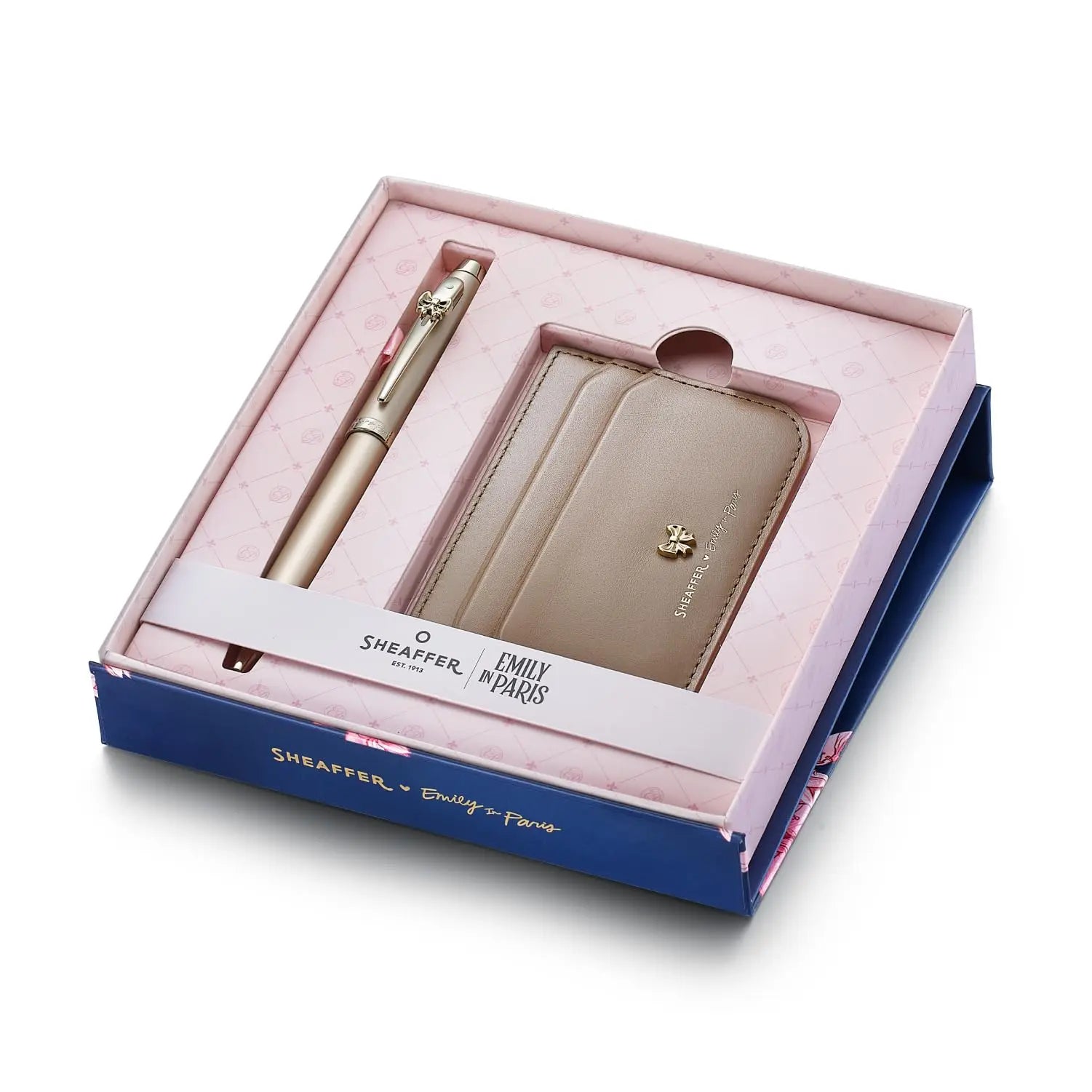Since its inception in 1924, the Sheaffer White Dot has stood as an enduring symbol of quality, craftsmanship, and innovation in the world of fine writing instruments. Over the past century, the White Dot has become synonymous with the Sheaffer brand, representing excellence and setting a standard of distinction that has withstood the test of time.
Origins of the Sheaffer White Dot: A Symbol of Excellence
The story of the Sheaffer White Dot begins with Walter A. Sheaffer, the visionary entrepreneur behind the iconic pen empire. In 1924, Sheaffer introduced the White Dot as a symbol of exceptional quality and craftsmanship, setting his pens apart from competitors in the burgeoning writing instrument industry. Inspired by the purity and clarity of the dot, Sheaffer chose white as the color to represent the superior standards of his pens.
Initially used to mark the company's premium pens backed by a lifetime warranty, the White Dot quickly became a hallmark of excellence, signifying pens that were not only beautifully crafted but also built to last a lifetime. The introduction of the White Dot marked a turning point for the Sheaffer brand, establishing its reputation as a leader in the field of fine writing instruments.
Evolution of the White Dot: Design and Symbolism
Over the decades, the Sheaffer White Dot has evolved both in design and symbolism, adapting to changing trends and consumer preferences while maintaining its core identity as a symbol of quality and craftsmanship. In its early years, the White Dot was a simple yet elegant addition to Sheaffer pens, typically located on the clip or barrel of the pen. As Sheaffer's reputation grew, so too did the prominence of the White Dot, with the emblem becoming larger and more prominently displayed on the company's premium models.
Beyond its physical appearance, the White Dot took on deeper significance as a symbol of trust and reliability. For generations of writers, professionals, and enthusiasts, the White Dot became a mark of assurance, signifying pens that were not only beautifully crafted but also built to last a lifetime.
The 1920s and 1930s: Expansion and Success
During the 1920s and 1930s, Sheaffer experienced significant expansion and success, fueled by the popularity of its White Dot pens. The company's innovative designs and commitment to quality made it a favorite among writers, professionals, and collectors alike. Sheaffer's pens were celebrated for their precision engineering, elegant design, and smooth writing performance, setting a new standard of excellence in the industry.
The White Dot played a central role in Sheaffer's success during this period, serving as a visual testament to the company's commitment to quality and craftsmanship. As Sheaffer's pens gained popularity among discerning consumers, the White Dot became increasingly recognized as a symbol of distinction and prestige, further solidifying the brand's reputation as a leader in the field of fine writing instruments.
World War II and Post-War Era Developments
The onset of World War II brought significant changes to the pen industry, as manufacturers shifted their focus to support the war effort. Despite the challenges of wartime production, Sheaffer continued to innovate and produce high-quality pens, earning accolades for its contributions to the war effort. The White Dot remained a symbol of excellence throughout this period, providing reassurance to consumers during uncertain times.
In the post-war era, Sheaffer experienced a period of growth and expansion as demand for its pens surged. The company introduced new models and designs, incorporating modern materials and technologies to meet the evolving needs of consumers. The White Dot continued to adorn Sheaffer's premium pens, serving as a reminder of the brand's enduring commitment to quality and craftsmanship.
Signature Models: The Balance and the Triumph
Among Sheaffer's most iconic models are the Balance and the Triumph, both of which feature the signature White Dot. The Balance, introduced in the 1930s, is celebrated for its streamlined design and balanced weight, making it a favorite among writers and collectors. The Triumph, introduced in the 1940s, features a distinctive conical nib and sleek, modern styling, reflecting the design trends of the post-war era.
These signature models exemplify Sheaffer's commitment to excellence and innovation, earning praise for their exceptional performance and timeless design. The White Dot serves as a badge of honor on these models, signifying pens that are not only beautiful to look at but also a pleasure to write with.
Technological Advancements: The Snorkel and PFM
In the 1950s and 1960s, Sheaffer introduced several technological advancements that further solidified its reputation as a leader in the pen industry. Among these innovations were the Snorkel filling system and the Pen for Men (PFM) series, both of which feature the iconic White Dot.
The Snorkel, introduced in 1952, revolutionized the way pens were filled, featuring a retractable tube that allowed for mess-free refills. The PFM series, introduced in 1959, was designed specifically for the needs of men, with larger nibs and bolder designs. These technological advancements set Sheaffer apart from its competitors, earning praise for their ingenuity and practicality.
Ownership Changes and Corporate Evolution
Throughout its long history, Sheaffer has undergone several ownership changes and periods of corporate evolution, each bringing new opportunities and challenges. In 1966, Sheaffer was acquired by Textron Inc., a major conglomerate with diverse business interests. Under Textron's ownership, Sheaffer continued to innovate and produce high-quality pens, benefiting from the financial stability and resources provided by its parent company.
In 1997, French stationery giant Bic acquired Sheaffer, ushering in a new era of change. Bic aimed to leverage Sheaffer's reputation for quality to expand its presence in the premium pen market. Despite the challenges of integrating two distinct brand philosophies, the acquisition allowed Sheaffer to reach a broader audience and maintain its commitment to excellence.
The most recent significant change in ownership occurred in 2014 when A. T. Cross Company, another historic name in the pen industry, acquired Sheaffer. This merger brought together two venerable brands with rich histories of innovation and craftsmanship. Under Cross's stewardship, Sheaffer has continued to evolve, balancing the preservation of its storied legacy with the demands of contemporary consumers.
Modern-Day Sheaffer: Balancing Tradition and Innovation
In the modern era, Sheaffer faces the challenge of maintaining its heritage while embracing new trends and technologies. The company has managed to strike this balance by honoring its traditions and continually pushing the boundaries of pen design and functionality.
Today, Sheaffer offers a diverse range of writing instruments that cater to different tastes and preferences. Classic models, such as the Balance and Triumph, are still celebrated for their timeless design and exceptional performance. These heritage products appeal to collectors and enthusiasts who appreciate the historical significance and craftsmanship of Sheaffer's early innovations.
At the same time, Sheaffer has introduced new lines that incorporate modern materials and technologies. The Sheaffer 100 and Sheaffer Intensity collections blend contemporary aesthetics with reliable performance, appealing to a new generation of users. These modern designs retain the core values of quality and craftsmanship that have always defined the Sheaffer brand.
Sheaffer has also embraced advancements in ink technology, offering a variety of fountain pen inks and refills that enhance the writing experience. The company’s commitment to sustainability is reflected in its efforts to develop eco-friendly products and packaging, aligning with broader industry trends towards environmental responsibility.
Furthermore, Sheaffer has expanded its product offerings to include accessories such as leather pen cases, desk sets, and writing instruments, allowing customers to complete their writing experience with complementary accessories.
Sheaffer Pens in Popular Culture and Collectibles Market
Over the years, Sheaffer pens have become cultural icons, appearing in films, television shows, and literature. From the hands of famous writers to the desks of world leaders, Sheaffer pens have left their mark on history, becoming cherished collectibles for enthusiasts around the world.
The White Dot, in particular, has become a sought-after symbol of quality and craftsmanship in the collectibles market. Vintage Sheaffer pens featuring the White Dot are highly prized by collectors, with rare models commanding premium prices at auctions and specialty pen shows.
In popular culture, Sheaffer pens have made appearances in numerous films and television shows, becoming synonymous with sophistication and elegance. From classic Hollywood films to contemporary television dramas, Sheaffer pens have been featured in the hands of leading characters, adding a touch of glamour and prestige to their on-screen personas.
In literature, Sheaffer pens have been celebrated by writers and poets for their smooth writing performance and elegant design. Famous authors such as F. Scott Fitzgerald and Ernest Hemingway were known to have used Sheaffer pens, further solidifying the brand's reputation as a favorite among literary figures.
In conclusion, the Sheaffer White Dot has endured as a symbol of quality, craftsmanship, and innovation for nearly a century. From its humble beginnings in 1924 to its continued relevance in the digital age, the White Dot has remained a hallmark of excellence, representing the enduring legacy of Walter A. Sheaffer and his vision for the perfect pen. As Sheaffer looks towards the future, it remains committed to upholding the standards of quality and innovation that have defined the brand for generations, ensuring that the White Dot continues to shine brightly for years to come.






